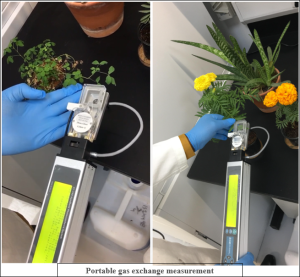
Portable gas exchange tool to determine the plant physiological behaviour in relation to the stress.
Ecologically, deserts are considered as ecosystems where light, temperatures and water deficit are the major environmental factors that limit plant physiology. Therefore, plant growing in the desert environments have spectacularly adjusted their mechanisms of survival according to the changing occurring in their natural habitats. Many mechanisms have been addressed including morphological, physiological, molecular, anatomical and genetical to explain their capacity of survival. With regard to the morphological adaptations, underground parts of the desert plants are much sizable compared with the above parts generally. This differentiation in size allow them to maximize their capacity of survival in up taking more nutrients and water. In many cases, leaves are compounds and sizably small. Some of the desert plants have adapted by storing important amounts of water in the leaves. Physiologically, desert plants and especially the perennial, have showed considerable adjustments in their stomata functioning. Different types of photosynthesis processes have been observed in those plants. Some of them have been adapted to perform this process during the day while the other, are more active in the night to avoid exposition to the heat and excessive light. At the seeds level, higher polymorphism was found in many desert plants. Naturally, most of the plants of our planet present one type of seed production whereas, in the arid regions, two to six types of seeds could be produced from the same plant. With respect to their location on plant, some desert plants have been adapted to the extreme condition by burying their seeds while the other seeds are exposed to the environmental conditions. In general, photosynthetic rate strongly depends on the photosynthetic apparatus. Any extreme changing in the environmental conditions can alter this process in plant. Therefore, many earlier works have tried to apply different methods to elucidate how these plants cope with the extreme environmental conditions, and one of them could be to use the non-invasive methods. The non-invasive methods allow to have a proper look at the plant under natural conditions and at the real time, and they do not require much time. With this regard, researchers of Fujairah Research Centre are trying to understand the mechanisms of survival of many desert plants through applying the non-invasive method.
